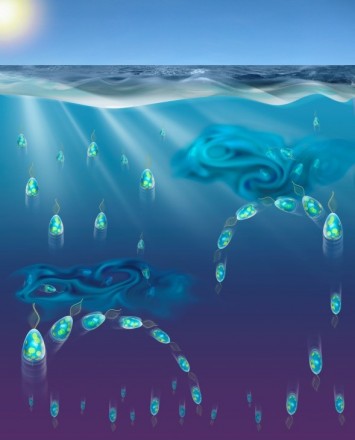Phytoplankton in flow
Written By
Category
Featured Reserach, Research
Posted On
February 1, 2013
Share This

Phytoplankton are photosynthetic microorganisms that form the base of most aquatic food webs and are responsible for half of global photosynthesis. Many species swim using flexible flagella and can reach remarkable speeds (up to 50 body-lengths/s) in relation to their small size (often 5-50 microns). Motility has many consequences within an ocean that is itself in constant motion. For example, using a combination of millifluidic experiments and mathematical modeling, we have shown that phytoplankton motility (biased by velocity gradients in the ambient water through a process called gyrotaxis) can explain the occurrence of the dramatic thin layers of high phytoplankton concentration that are often observed in the ocean and thought to sometimes be precursors of red tides. We also discovered that the velocity gradients that characterize ocean turbulence at the smallest scales can result in strong microscale patchiness in the distribution of phytoplankton, depending on their swimming speed and stability. Coupling of shape and flow could also change light climate in the ocean by increasing the optical backscattering of natural plankton assemblages, through the preferential alignment of elongated plankton induced by fluid shear. However, despite their small size, phytoplankton are not passively at the mercy of fluid flow. Recently we have found that phytoplankton display a striking, active behavioral response to mechanical cues (periodic changes in orientation relative to gravity) associated with the smallest turbulent eddies in the ocean, whereby a subtle change in morphology triggers a shift in the direction of migration among phytoplankton that commute vertically across the water column. Furthermore, we have recently had the opportunity to test the role of fluctuations in gravity itself by taking phytoplankton on a zero-gravity flight. We are now learning more about the behavioral and adaptive strategies of phytoplankton in the face of turbulence through scaled up experiments in a turbulence tank, together with single-cell tracking and transcriptomics.
For more information, please contact Anupam Sengupta (anupams@ethz.ch), Francesco Carrara (carraraf@ethz.ch), Jeanette Wheeler (jwheeler@ethz.ch) or Ulrike Pfreundt (pfreundt@ifu.baug.ethz.ch).